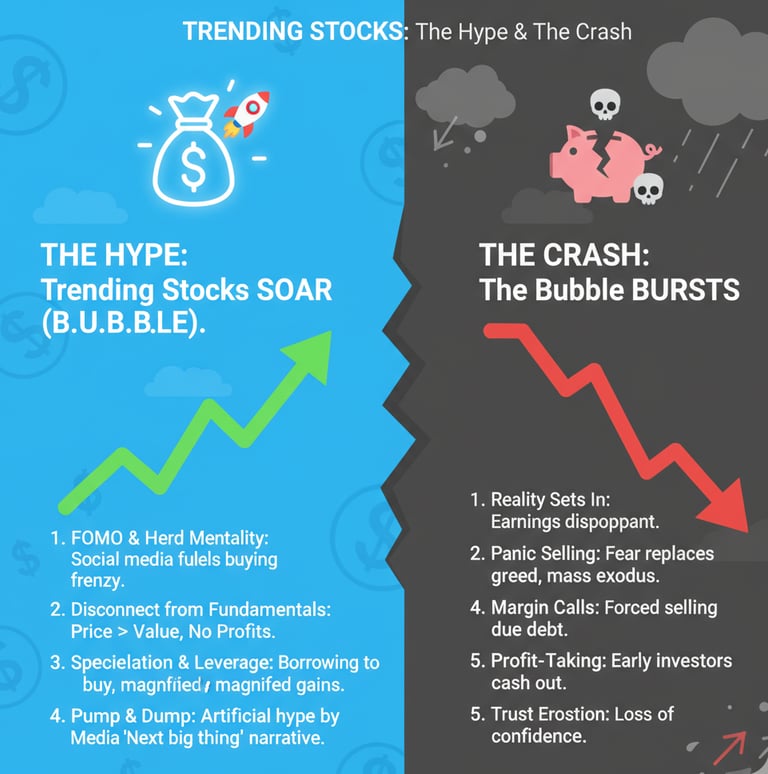Why “Trending” Stocks Get Hype — and Then Crash
Ever wonder why trending stocks or sectors skyrocket overnight — only to crash weeks later? Here’s the psychology, algorithms, and money flow behind stock market hype cycles.
RAVINDRA PRAJAPATI (EDUCATIONAL BLOG)
10/10/20252 min read


1. The “Attention = Money” Loop
In the modern market, attention drives capital — not always fundamentals.
When a stock starts trending on social media or news platforms (say, “AI,” “EV,” or “silver boom”), it triggers curiosity and FOMO (Fear of Missing Out).
Retail investors rush in.
Trading volume spikes.
Algorithms detect that surge and amplify it further.
The price climbs faster than earnings or business reality.
This loop feeds itself — until attention fades.
2. Herd Psychology in Action
People naturally trust what others are buying. It feels safe to follow the crowd.
But in the market, crowd confidence often peaks before price does.
Everyone believes “this time is different.”
Media coverage turns positive.
Latecomers buy at inflated prices.
When big players quietly start selling, small investors are still buying — and that’s when the fall begins.
3. The Role of Algorithms and Trading Bots
AI-driven systems track momentum, not value.
So, when something trends on Reddit, YouTube, or X (Twitter), algorithmic trading firms jump in automatically.
That’s why you see:
Sharp 1–2 day rallies
Sudden reversals
No clear fundamental reason behind the move
It’s digital herd behavior — faster and more brutal.
4. Lack of Fundamental Backing
In hype phases, prices rise before earnings, innovation, or real cash flows justify them.
Investors buy the story, not the substance.
Examples:
EV stocks in 2021
Meme stocks like GameStop & AMC
Silver mini-squeeze moments
Once the hype cools and quarterly results disappoint, stocks correct sharply — often back to where they started.
5. Profit-Taking & Liquidity Traps
Smart investors and institutions ride the hype early — but they also exit early.
When they sell to book profits, retail investors are left holding the bag.
This creates a liquidity trap: too many sellers, not enough buyers.
Result → sudden price collapse.
6. Real-Life Lesson for Investors
Trends are signals, not guarantees.
If something is trending, it means:
The opportunity is visible to everyone.
The easy money may already be gone.
Smart investors:
✅ Enter early (before the buzz)
✅ Take partial profits when hype builds
✅ Rebalance when valuation looks stretched
Final Thought
The stock market runs on a mix of emotion + algorithm + fundamentals.
When emotion dominates, prices behave like fashion trends — hot today, forgotten tomorrow.
Your edge is staying rational while others chase what’s “trending.”
RAVINDRA PRAJAPATI, Not a sebi registered
FOLLOW Us
ravindra.prajapati1122@gmail.com
+91 9795187745
© 2025. PiPiFinTech All rights reserved.
Contact Us
ABOUT Us
Our mission is to empower you to maximize every single penny and best solution for wealth generation and management for every mature age group.
Product TOPICS
Digital E-Wealth Platform
Mutual Funds
Education Planning
Insurance
FD and Bonds
Retirement Planning
Wealth Creation
(Disclaimers : Mutual Fund investments are subject to market risks, please read scheme related documents carefully.)
